
The Poeciliidae are a family of freshwater fishes of the order Cyprinodontiformes, the tooth-carps, and include well-known live-bearing aquarium fish, such as the guppy, molly, platy, and swordtail. The original distribution of the family was the Southeastern United States to north of Río de la Plata, Argentina, and Africa, including Madagascar. Due to release of aquarium specimens and the widespread use of species of the genera Poecilia and Gambusia for mosquito control, though, poeciliids can today be found in all tropical and subtropical areas of the world. In addition, Poecilia and Gambusia specimens have been identified in hot springs pools as far north as Banff, Alberta.
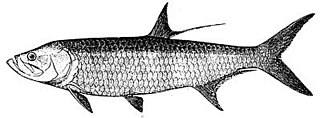
The Elopiformes are the order of ray-finned fish including the tarpons, tenpounders, and ladyfish, as well as a number of extinct types. They have a long fossil record, easily distinguished from other fishes by the presence of an additional set of bones in the throat.

The bonefish is the type species of the bonefish family (Albulidae), the only family in order Albuliformes.

Rhodeus is a genus of cyprinid fish, consisting of 23 species called bitterlings. The scientific name is derived from the Greek word rhodeos, meaning "rose". Most species in the genus are restricted to Asia, but two species are found in Europe.

The ladyfish or tenpounder is a species of fish in the genus Elops, the only genus in the monotypic family Elopidae.

The superorder Elopomorpha contains a variety of types of fishes that range from typical silvery-colored species, such as the tarpons and ladyfishes of the Elopiformes and the bonefishes of the Albuliformes, to the long and slender, smooth-bodied eels of the Anguilliformes. The one characteristic uniting this group of fishes is they all have leptocephalus larvae, which are unique to the Elopomorpha. No other fishes have this type of larvae.
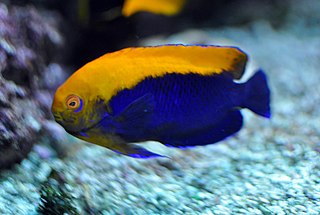
The flameback angelfish, also known as the flameback pygmy angelfish, Brazilian flameback angelfish, Caribbean flameback angelfish or fireball angelfish, is a species of marine ray-finned fish, a marine angelfish belonging to the family Pomacanthidae. It is found in the western Atlantic Ocean.

The Pacific ladyfish, also known as the Pacific tenpounder and Machete, is a species of ray-finned fish in the genus Elops, the only genus in the monotypic family Elopidae. The Pacific ladyfish can be found throughout the southwest U.S. and other areas in the Pacific Ocean.

The Hawaiian ladyfish, also known as the Hawaiian tenpounder or banana fish, is a species of ray-finned fish in the family Elopidae. It is sometimes referred to as the giant herring, though it is not closely related to the true herrings of the family Clupeidae. Its Hawaiian name is awa 'aua. It is native to the west central Pacific Ocean, and the current classification may in fact consist of several species.

The West African ladyfish is a species of ray-finned fish in the family Elopidae. It is native to the coastal waters of the eastern Atlantic Ocean, from Senegal to Angola. It is also known as the Guinean ladyfish. Some have been known to grow to 20 lb (9.1 kg).
The Senegalese ladyfish is a species of ray-finned fish in the family Elopidae, and is native to the coastal waters of the eastern Atlantic Ocean from Mauritania to the Democratic Republic of the Congo. It is often confused with the West African ladyfish, Elops lacerta, and can be distinguished only by the number of gill rakers on the lower part of the first gill arc, and the number of scales on the lateral line.
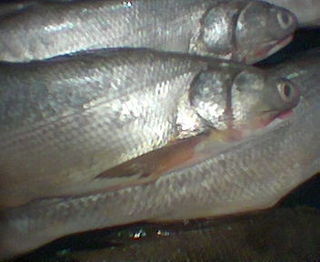
Elops machnata, the tenpounder, is a species of ray-finned fish in the family Elopidae in the order Elopiformes. This species is found in coastal regions of the Indian Ocean.

The Atlantic tarpon is a ray-finned fish that inhabits coastal waters, estuaries, lagoons, and rivers. It is also known as the silver king. It is found in the Atlantic Ocean, typically in tropical and subtropical regions, though it has been reported as far north as Nova Scotia and the Atlantic coast of southern France, and as far south as Argentina. As with all elopiformes, it spawns at sea. Its diet includes small fish and crustaceans.
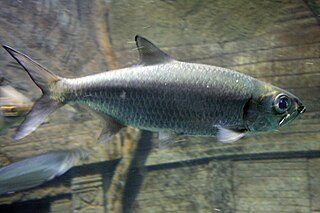
The Indo-Pacific tarpon, also known as the oxeye herring or simply herring due to its superficial resemblance to the true herrings, of which it is not a member, is the smaller of the two species of tarpon and lives in Indo-Pacific waters.

Albulidae is a family of fish, commonly known as the bonefishes, that are popular as game fish in Florida, select locations in the South Pacific and the Bahamas and elsewhere. The family is small, with 11 species in 3 genera. Presently, the bonefishes are in their own order: Albuliformes. The families Halosauridae and Notacanthidae were previously classified in this order, but are now, according to FishBase, given their own order Notacanthiformes. The largest bonefish caught in the Western Hemisphere is a 16-pound, 3 ounce example caught off Islamorada, Florida, on March 19, 2007.

Pseudanthias is a genus of colourful reef fishes of the subfamily Anthiinae, part of the family Serranidae, the groupers and sea basses. They are found in the Indo-Pacific. The species belonging to this genus have a diet consisting of zooplankton, and are haremic. Fishes currently included in this genus were earlier part of the genus Anthias. Pseudanthias is the largest anthiine genus
Antofagastaichthys is an extinct genus of ray-finned fish that lived in what is now Chile during the Oxfordian stage of the Late Jurassic epoch. It contains one species, A. mandibularis, which is known from several fragmentary specimens discovered in the El Profeta Formation of Antofagasta Province.

Tarpons are fish of the genus Megalops. They are the only members of the family Megalopidae. Of the two species, one is native to the Atlantic, and the other to the Indo-Pacific Oceans.
The malacho or Southern ladyfish, is a species of ray-finned fish in the genus Elops, the only genus in the monotypic family Elopidae.
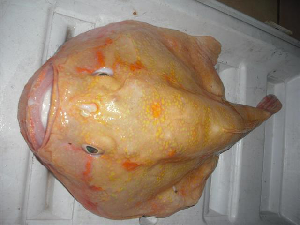
The coffinfish or furry coffinfish is a species of sea toad of the family Chaunacidae. It is found in salty temperate waters of southwestern Pacific, off east coast of Australia. The coffinfish was first discovered around February 1997 in Sicily, Italy by the skipper of the Libra, which was a trawler who was harbored in Mazara at the time. It can be also found in depths of 50–300 m (164–984.3 ft). Deep sea crab fishermen off the east coast of Florida pull them up from depth ranging from 5,000–8,000 feet about 54–68 miles off the coast. They have a globose and spiny body that grows to a maximum length of 22.0 cm (8.7 in) and a black mouth lining and an illicium on the snout that can be lowered into a groove.

















